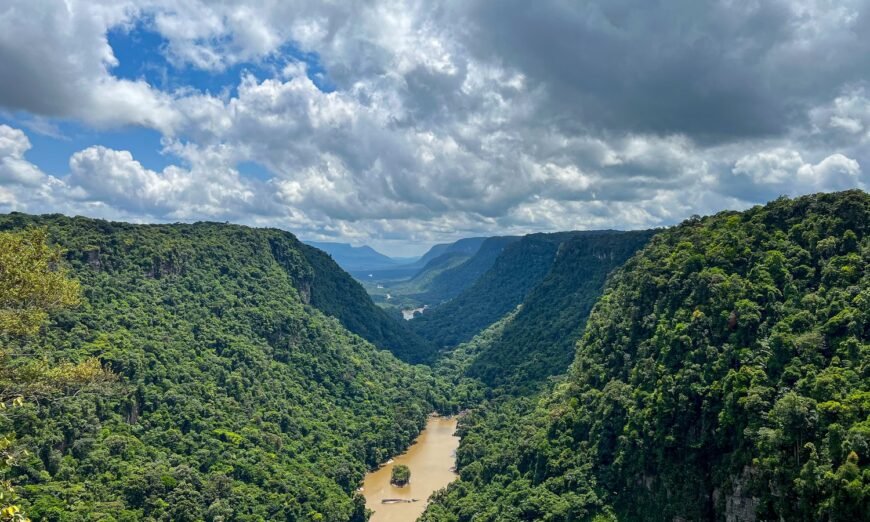High above the tropical canopy and deep within South America’s northeast corner lies one of Earth’s most spellbinding natural treasures: the Guiana Highlands. Spanning five countries—Guyana, Suriname, French Guiana, Venezuela, and northern Brazil—this ancient upland is a pristine wilderness of towering mountains, lush forests, tumbling waterfalls, and rich biodiversity. It’s not just a destination; it’s a living, breathing world unto itself. The Guianan Highlands moist forests ecoregion lies predominantly within the eastern portion of the Orinoco Basin, which drains into the Caribbean Sea from Venezuela. However, a portion of the ecoregion also extends into the Amazon Basin, with rivers like the Rio Uraricuera and Rio Branco flowing into the mighty Amazon.
The Guiana Highlands are part of the Guiana Shield, one of the oldest geological formations in the world, dating back nearly 2 billion years. This highland region is draped in thick rainforests—many still unexplored—and is considered one of the planet’s most intact forest ecosystems. It plays a critical role in climate regulation and water cycling for the entire Amazon basin. In Guyana alone, over 80% of land remains forested, and within the highlands, these forests take on ethereal forms—mist-shrouded cloud forests, mountain rainforests, and flooded river forests filled with sounds of nature. These ecosystems are so remote and unspoiled that they shelter species found nowhere else on Earth.
The mountain ranges of the Guiana Highlands are not just geographical features—they are sacred icons of landscape and lore. Most famous among them is Mount Roraima, a flat-topped tepui that inspired Arthur Conan Doyle’s The Lost World. Rising like a fortress above the jungle, its otherworldly presence makes it a dream for trekkers and geologists alike.Further south in Guyana lie the Pakaraima Mountains, home to cascading rivers and waterfalls, including the awe-inspiring Kaieteur Falls. Plunging 741 feet, Kaieteur is one of the world’s highest single-drop waterfalls and arguably one of its most beautiful. Unlike heavily trafficked falls elsewhere, Kaieteur is often experienced in near solitude—a spiritual encounter with raw nature.
Several notable protected areas have been established within or encompassing portions of this ecoregion, including the Alto Orinoco-Casiquiare Biosphere Reserve, Canaima National Park, Parima-Tapirapecó National Park, Serranía La Neblina National Park, and Pico da Neblina National Park. These protected areas aim to safeguard the unique biodiversity and ecological integrity of the Guianan Highlands moist forests, ensuring that this remarkable ecosystem can continue to thrive for generations.
Kaieteur National Park protects the surrounding rainforest and is home to the tiny yet striking golden rocket frog, endemic to the bromeliads growing on the rocks of the falls. Iwokrama Forest, a vast protected area co-managed by indigenous communities and researchers, is a global model for sustainable forest management and ecotourism. Kanuku Mountains Protected Area, near Lethem, contains both rainforest and savanna ecosystems and is among the most biologically diverse regions in the Guiana Shield.
Due to the region’s isolation, many species have evolved independently, leading to exceptional rates of endemism—especially among amphibians, reptiles, and plants.
The botanical diversity of the highlands is staggering. Forest floors and mountain slopes are rich with aromatic and medicinal plants used for generations by indigenous healers. Wild ginger, turmeric, bush thyme, and Amazonian pepper are just a few of the fragrant treasures that grow naturally here.Herbal teas, oils, and salves made from rainforest plants are increasingly drawing interest from wellness tourists and researchers. Notable birds found in the ecoregion include the white-cheeked pintail (Anas bahamensis), aplomado falcon (Falco femoralis), brown-throated parakeet (Aratingapertinax), pavonine cuckoo (Dromococcyxpavoninus), vermiculated screech owl (Otus guatemalae), burrowing owl (Athene cunicularia), various emerald and hummingbird species from the Amazilia genera, chestnut-tipped toucan (Aulacorhynchusderbianus).
Guided forest walks led by local experts offer insight into this living pharmacy of the forest. Long before explorers arrived, the highlands were home to vibrant indigenous cultures who developed deep knowledge of the land and its rhythms. Today, groups such as the Macushi, Patamona, Wapishana, and Wai Wai continue to live sustainably in the region.
In a world searching for authentic, low-impact travel experiences, Guyana has quietly emerged as one of the most promising eco-tourism destinations on Earth. With its untouched rainforests, majestic waterfalls, rich indigenous heritage, and commitment to environmental stewardship, Guyana is crafting a unique niche in sustainable tourism. Far from the crowded beaches and over-touristed cities, Guyana offers a different kind of adventure—one that’s rooted in conservation, community, and culture. Visitors to community-run eco-lodges like Surama, Rewa, or Annai can experience life in these villages, enjoy traditional foods, learn basket weaving, and hear legends passed down through generations. It’s a form of tourism that connects the visitor not only to nature but to humanity’s ancient bond with it.
As global travellers seek more meaningful, environmentally conscious experiences, the Guiana Highlands are rapidly gaining attention. Guyana’s commitment to low-carbon development, community-based tourism, and conservation makes it a model for sustainable tourism. Guyana’s flagship policy, promoting economic growth while protecting its forests. The LCDS has received international praise and funding from partners like Norway.
The government has invested in improving access to remote areas, supporting eco-enterprises, and training indigenous guides. Visitor numbers are rising, but growth is carefully managed to maintain the authenticity and ecological integrity of the region. Accolades from National Geographic, BBC Travel, and Lonely Planet have highlighted Guyana and the Guiana Highlands as top eco-tourism destinations. A Journey into the Wild Soul of the Planet.
The Guiana Highlands remain one of the last great wild frontiers—untrammeled, majestic, and profoundly humbling. In their soaring cliffs, deep forests, and whispering rivers, they hold the stories of Earth’s past and the promise of a sustainable future. Guyana’s approach to tourism isn’t just about attracting visitors—it’s about sharing the story of a nation committed to balance. Here, tourism doesn’t harm the environment; it protects it. It doesn’t displace communities; it empowers them. It doesn’t dilute culture; it celebrates it.

